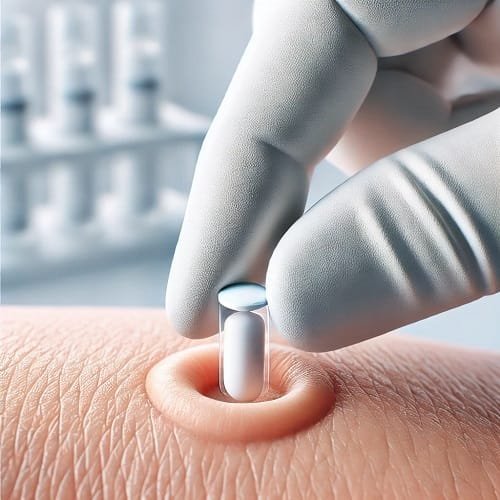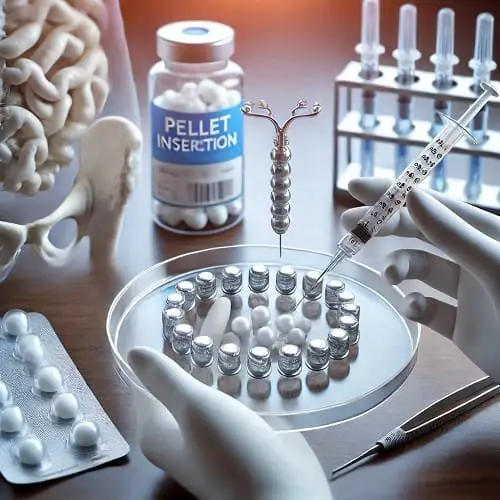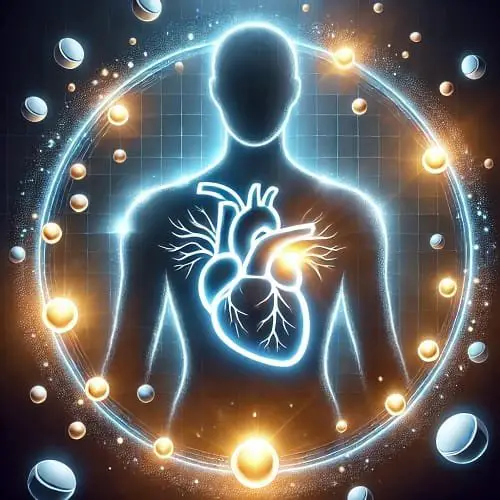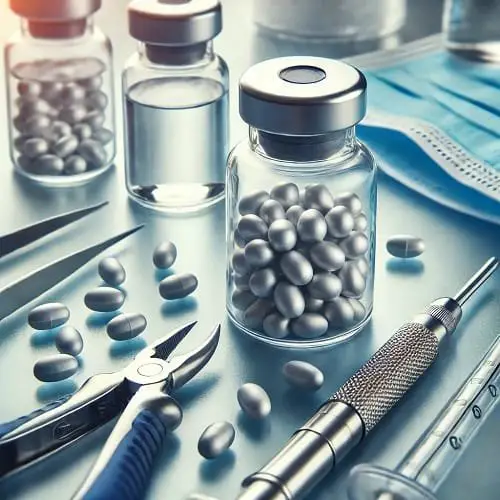What Are Hormone Pellets?

Hormone pellets are a form of hormone therapy used in hormone replacement therapy (HRT) to treat various hormonal imbalances. These small, rice-sized hormone pellet implants contain bioidentical hormones, which are chemically identical to the hormones naturally produced by the body. The pros and cons of hormone pellets lie in their ability to offer a consistent, reliable, and long-lasting method of delivering hormones directly into the bloodstream.
Table of Contents
How Hormone Pellets Work
Once inserted under the skin, typically in the hip or buttocks, the hormone pellet implants slowly release a steady, controlled dose of hormones into the body over a period of several months. This gradual release helps maintain balanced hormone levels, providing patients with a more consistent experience compared to other forms of hormone therapy, such as pills or injections, which can cause hormone fluctuations. The body absorbs these bioidentical hormones, like estradiol or testosterone, as they mimic the body’s natural processes, offering a more natural form of hormone replacement.
The Pellet Insertion Procedure
The pellet insertion procedure is relatively simple and minimally invasive. A healthcare provider numbs the area where the pellet will be placed, typically in the hip or buttock. Using a small incision, the pellets are inserted under the skin, where they remain for 3 to 6 months, depending on the type of pellet used. The procedure itself is quick, usually taking only about 15 minutes, and is typically done in an outpatient setting. While the insertion site may be slightly tender for a few days, the process is generally well-tolerated by most patients.
Why Hormone Pellet Therapy Is Becoming Popular
Hormone pellet therapy is growing in popularity due to its convenience and effectiveness. Unlike daily pills or frequent injections, the pellets offer a hormonal balance that lasts for months, reducing the hassle of daily hormone management. This long-term solution has made it a favorite among those seeking a more consistent and low-maintenance approach to hormone replacement. Whether it’s addressing issues related to menopause, low testosterone, or other hormone-related conditions, hormone pellets provide a promising and efficient alternative to traditional hormone therapy options.
Benefits of Hormone Pellets

Hormone pellets offer several significant benefits, making them a popular choice for hormone replacement therapy. While there are pros and cons of hormone pellets, their advantages are particularly notable for individuals seeking a long-term, low-maintenance solution for hormonal imbalance. Here’s a breakdown of some of the most impactful benefits:
Improved Hormonal Balance
One of the key benefits of hormone pellets is their ability to provide a consistent and steady release of hormones, ensuring balanced hormones throughout the day. Unlike oral pills or topical creams, which can cause fluctuations in hormone levels, the pellets release hormones gradually, offering a more natural and consistent supply. This helps maintain stable hormone levels for months at a time, reducing the risks associated with hormone spikes and drops.
Hormone imbalance can affect various aspects of health, including mood, energy, and weight. For many individuals, this imbalance can lead to unpleasant symptoms such as mood swings, fatigue, and weight gain. By using bioidentical hormone replacement, hormone pellets help restore equilibrium to the body’s hormone levels, providing relief from these common issues. As a result, patients often report feeling more balanced, with fewer mood swings and improved overall well-being.
Long-Lasting Results
Another significant advantage of hormone pellets is their long-lasting effects. Once inserted, the pellets typically last between 3 to 6 months, releasing hormones steadily during this period. This extended duration makes them a highly convenient option compared to other hormone therapy methods, such as pills, patches, or creams, which require daily or weekly application.
For those tired of the constant maintenance of daily doses or frequent doctor visits for injections, hormone pellet implants offer a long-term solution. The ability to go several months without having to think about hormone therapy is a major appeal for many patients, allowing them to focus on their daily lives without the constant need for attention to their treatment.
Enhanced Energy, Mood, and Libido
Many individuals undergoing hormone replacement therapy notice a significant improvement in their energy levels, mood, and libido. By restoring proper hormone levels, hormone pellets can help alleviate common symptoms of hormonal imbalance, such as fatigue, irritability, and low sexual drive. Patients often report feeling more energetic and mentally clear, leading to a better quality of life.
For women, menopause treatment with bioidentical hormones can be life-changing. Hormonal fluctuations during menopause can contribute to significant changes in mood, sleep patterns, and energy levels. By using hormone pellets, many women find that these symptoms are reduced, and their overall sense of well-being is restored. Similarly, men undergoing testosterone therapy with pellets often experience renewed vitality, improved mood, and a boost in sexual function.
Minimal Maintenance
One of the standout benefits of hormone pellets is their minimal maintenance. Unlike oral medications or topical treatments, which require daily attention, hormone pellets are a “set it and forget it” solution. Once inserted, the pellets continue to deliver hormones over several months, allowing patients to go about their lives without the need for constant medication.
This ease of use is especially valuable for those with busy schedules or individuals who prefer a more straightforward, low-maintenance treatment option. Furthermore, because hormone pellet implants are inserted under the skin only once every few months, there is no need for frequent doctor visits or regular injections. The convenience factor of pellet therapy is a key reason many patients choose it over other methods of hormone replacement.
This section outlines the primary benefits of hormone pellets, highlighting their role in providing consistent hormone levels, long-lasting results, improved overall well-being, and minimal maintenance. While the pros and cons of hormone pellets should be weighed carefully, these benefits make it an appealing option for many individuals seeking effective hormone replacement therapy.
RELATED TOPICS:
Can a Bladder Infection Affect Period? A Complete Guide
Can a UTI Cause a Late Period? Full Guide
Clicking Sound While Breastfeeding: Why It Happens
Risks and Side Effects of Hormone Pellets

While hormone pellets offer numerous benefits, it’s important to be aware of the risks and side effects associated with this form of hormone therapy. As with any medical treatment, the pros and cons of hormone pellets must be weighed carefully. While many people experience positive outcomes, there are potential downsides to consider, especially when it comes to side effects and long-term health impacts.
Common Side Effects
After pellet insertion, some patients experience short-term side effects at the insertion site. This may include mild pain, swelling, or bruising, which is typically temporary and resolves within a few days. These side effects are generally mild and do not indicate a serious problem. However, some individuals may also experience other mild effects, such as headaches or mood swings. These symptoms are common when adjusting to a new form of hormone therapy and often subside as the body adapts to the pellets.
While these side effects are usually short-lived, it’s important to keep in mind that any form of hormone replacement therapy can cause some level of discomfort. Hormonal imbalance can lead to mood changes, fatigue, and even weight gain in some cases, especially in the early stages of treatment. If these side effects persist or become more severe, it’s important to consult with a healthcare provider to adjust the treatment or explore other options.
Potential Long-Term Risks
Although hormone pellet therapy can provide long-term benefits, there are also potential long-term risks associated with bioidentical hormone replacement. Some individuals may experience acne, excessive hair growth, or changes in appetite. These side effects can occur due to fluctuations in hormone levels, particularly if the pellets are releasing too much or too little of the hormone.
The risk of developing acne or unwanted hair growth is more common among men undergoing testosterone therapy, as testosterone can stimulate sebaceous glands in the skin, leading to breakouts or excessive oil production. Similarly, women may notice weight gain or changes in mood, especially if the hormone pellet implants release higher doses of estrogen or testosterone than their bodies need.
Over time, hormonal imbalance could also contribute to issues like mood instability, changes in libido, or even long-term changes in body composition. These potential side effects are something to keep in mind when considering hormone pellet implants as part of a long-term hormone therapy strategy.
Inconsistent Hormone Dosing
One of the most significant challenges with hormone pellets is the potential for inconsistent hormone dosing. While pellets are designed to release hormones steadily over a period of 3 to 6 months, some patients may find that their hormone levels fluctuate, leading to side effects like fatigue, irritability, or irregular bleeding. This can occur if the pellet insertion does not deliver a consistent dose or if the body metabolizes the hormone too quickly or slowly.
Finding the correct dosage of hormone pellets can be difficult, especially for individuals who are sensitive to changes in hormone levels. For instance, if the pellets release too much hormone, it can result in side effects such as weight gain, excessive sweating, or mood swings. On the other hand, if the release is too low, individuals may experience symptoms of hormonal imbalance, such as fatigue or depression. Regular follow-ups with a healthcare provider are essential to ensure the pellets are working effectively and providing the appropriate hormone levels.
Pellets Expelling or Becoming Ineffective
In some cases, hormone pellet implants may become ineffective or be expelled from the body before their intended time. This can happen if the pellets are not placed properly during pellet insertion or if there are complications with the procedure. When this occurs, the hormone therapy may no longer be effective, leading to a return of symptoms like fatigue, mood swings, or other signs of hormonal imbalance.
In rare cases, pellets may expel from the body or move to a different location under the skin, requiring pellet removal. This situation can be uncomfortable and may require a follow-up procedure to remove the misplaced pellet. If the pellets become ineffective or are expelled, patients may need to undergo the procedure again to ensure proper hormone levels are maintained.
Additionally, over time, the hormone pellets may stop releasing hormones effectively. If this happens, it may be necessary to replace the pellets sooner than expected. Regular monitoring of hormone levels can help detect any issues with pellet efficacy, allowing healthcare providers to make timely adjustments.
While the pros and cons of hormone pellets are often debated, being informed about the potential side effects and long-term risks is crucial for those considering this therapy. Understanding these potential drawbacks allows individuals to make informed decisions and collaborate closely with healthcare providers to ensure the therapy is as effective and safe as possible.
RELATED TOPICS
Laser Hair Removal While Breastfeeding: Is It Safe or Risky?
Healthy Protein Balls for Breastfeeding Moms
Can I Take Creatine While Breastfeeding? Key Facts
Who Should Consider Hormone Pellet Therapy?

Hormone pellet therapy can be a highly effective form of hormone replacement therapy (HRT) for individuals dealing with hormonal imbalances. While hormone pellets offer numerous benefits, not everyone may be the ideal candidate for this form of treatment. It’s important to consider the conditions, symptoms, and lifestyle factors that make certain individuals more likely to benefit from this therapy.
Ideal Candidates for Hormone Pellet Therapy
Women in menopause often turn to hormone pellet therapy as a solution for managing the symptoms associated with menopause therapy. As women age, particularly during and after menopause, they experience a significant drop in estrogen and progesterone, leading to symptoms like hot flashes, night sweats, irritability, and mood swings. Bioidentical hormones, administered through pellet insertion, can help restore hormonal balance and reduce these uncomfortable symptoms, making it a popular option for HRT for women.
Similarly, men with low testosterone can benefit greatly from testosterone therapy for women or men, as low levels of this hormone can lead to fatigue, decreased libido, weight gain, and mood disorders. For both men and women, hormonal imbalances caused by age-related hormone decline can have a significant impact on overall quality of life. Hormone pellet therapy provides a steady release of hormones, helping restore energy, mood, and sexual function.
Why Some Patients Prefer Hormone Pellets Over Other Methods
While there are multiple methods for hormone replacement therapy, including pills, patches, and creams, many patients prefer hormone pellets because of their convenience and long-lasting effects. Unlike oral medications or topical treatments that require daily use, hormone pellets offer a “set it and forget it” approach, with the pellets providing a steady hormone release for up to six months. This reduces the need for frequent applications, doctor visits, or constant attention, making them an attractive option for individuals with busy schedules.
Additionally, some people find that the consistency of hormone pellets helps them avoid the fluctuations in hormone levels that can sometimes occur with other methods. This steady and predictable release can lead to more stable results and better overall management of hormonal imbalances.
In summary, hormone pellets are most beneficial for individuals experiencing significant hormonal imbalances related to age or conditions like menopause. Whether it’s HRT for women or testosterone therapy, many patients choose pellets over other methods for their long-term effectiveness and ease of use. However, it’s important to consult with a healthcare provider to determine if this therapy is the right fit based on individual health needs and lifestyle.
How to Get Started with Hormone Pellet Therapy

If you’re considering hormone pellet therapy, the first step is to consult with a qualified medical professional who specializes in hormone replacement therapy. Finding the right HRT doctor is essential to ensure the procedure is performed safely and effectively. Here’s a simple guide to help you get started:
Step 1: Finding a Specialist
Begin by researching doctors who specialize in hormone pellet insertion and have experience with hormonal imbalances. Look for a healthcare provider with expertise in bioidentical hormone replacement or HRT and a track record of positive patient outcomes. Referrals from friends, family, or your primary care physician can also be valuable.
Step 2: Hormone Pellet Consultation
During your hormone pellet consultation, your doctor will review your medical history and discuss your symptoms and goals. They may recommend blood tests to assess your hormone levels and determine if pellet therapy is the right treatment for you. This is also the time to ask any questions about the pellet therapy procedure, potential side effects, and the benefits of the treatment.
Step 3: Pellet Therapy Procedure
Once you’ve decided to move forward with hormone pellet therapy, the pellet insertion procedure is typically quick and straightforward. The pellets are inserted just beneath the skin, usually in the hip or buttocks area. After insertion, you’ll likely be monitored for a short period to ensure everything is going smoothly.
It’s crucial to work with a trusted and experienced doctor when considering hormone pellets. Their expertise will ensure you receive personalized care and effective treatment for your hormonal imbalances.
Conclusion: Is Hormone Pellet Therapy Right for You?
In conclusion, hormone pellet therapy offers numerous advantages, including long-lasting results, minimal maintenance, and improved hormonal balance. Many individuals experience enhanced energy, mood, and libido, while also benefiting from a steady release of hormones without the need for daily applications or frequent visits to the doctor. However, as with any medical treatment, it’s important to consider the pros and cons of hormone pellets. While the therapy is effective for many, potential side effects and risks, such as hormonal imbalances or pellet expulsion, should be carefully weighed.
The pros and cons of hormone pellets will vary depending on your personal health goals, the severity of your symptoms, and your preferences for treatment. If you’re interested in hormone therapy results, it’s essential to consult with a trusted HRT doctor who can assess your individual situation, explain the treatment effectiveness, and guide you in making the best decision for your health.
Ultimately, hormone pellet therapy may be the right choice for you if you’re looking for a long-term, hassle-free solution to restore your hormone balance. Don’t hesitate to discuss your options with a healthcare provider to determine the best treatment plan for your needs.
Frequently Asked Questions (FAQ)
What are the common side effects of hormone pellets?
The most common side effects of hormone pellet therapy include mild discomfort at the pellet insertion site, such as pain, swelling, or bruising. Some individuals may also experience headaches or mood swings as their bodies adjust to the new hormone levels.
How long do hormone pellets last?
Hormone pellets typically last between 3 to 6 months, offering a long-lasting solution compared to other forms of hormone replacement therapy that require daily applications or regular doctor visits.
Who should avoid hormone pellet therapy?
Hormone pellet therapy may not be suitable for individuals with certain conditions, such as hormone-sensitive cancers, liver disease, or blood clotting disorders. It’s crucial to consult with your healthcare provider to determine if this therapy is appropriate for your specific health needs.
Is hormone pellet therapy better than other forms of hormone replacement?
Each hormone therapy method has its advantages. Hormone pellet therapy offers convenience with fewer applications and more consistent hormone levels compared to pills, patches, or creams. However, the best choice depends on individual needs and preferences. Speak with your doctor to weigh the benefits and side effects of all available options.






